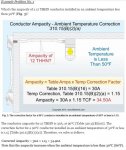Having a difficult time understanding the “whichever is less” concept here.
"Where two different ampacities apply to adjacent portions of a circuit, the higher ampacity shall be permitted to be used beyond the point of transition, a distance equal to 3.0 m (10 ft) or 10 percent of the circuit length figured at the higher ampacity, whichever is less."
So if the lower ampacity does not exceed 10 feet or 10%, whichever is less, the higher ampacity can be used.
Examples:
For a smaller run length of 50 feet, 4 feet of lower ampacity, allows the entire length of the run to be used at higher ampacity. In relation to the run length, this is 8 percent of the run.
Now if you have 2,000 feet run length, and 11 feet of reduced ampacity, the whole circuit must be considered reduced ampacity?? In comparison, this is just .5% run length.
So in the 1st example, 8% of reduced ampacity allows full ampacity to be wire to be used. But in the 2nd example, a .5% run length of reduced ampacity governs the entire run length.
Why isn't this just based on percentage?
"Where two different ampacities apply to adjacent portions of a circuit, the higher ampacity shall be permitted to be used beyond the point of transition, a distance equal to 3.0 m (10 ft) or 10 percent of the circuit length figured at the higher ampacity, whichever is less."
So if the lower ampacity does not exceed 10 feet or 10%, whichever is less, the higher ampacity can be used.
Examples:
For a smaller run length of 50 feet, 4 feet of lower ampacity, allows the entire length of the run to be used at higher ampacity. In relation to the run length, this is 8 percent of the run.
Now if you have 2,000 feet run length, and 11 feet of reduced ampacity, the whole circuit must be considered reduced ampacity?? In comparison, this is just .5% run length.
So in the 1st example, 8% of reduced ampacity allows full ampacity to be wire to be used. But in the 2nd example, a .5% run length of reduced ampacity governs the entire run length.
Why isn't this just based on percentage?


